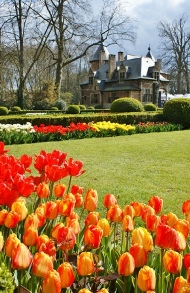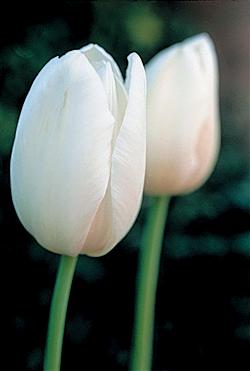 Tulips Mixed. Picture courtesy HadecoTulips are one of the most recognisable and regal of flowers, which have captured the imagination of poets and artists for centuries. The tulip is a bulbous perennial plant with showy flowers, belonging to the family Liliaceae. There are about 109 species indigenous to a vast area encompassing temperate mountainous and arid regions; extending from the eastern Mediterranean, Eastern Europe, to North Africa, Asia Minor and Iran, to the Northwest of China.
Tulips Mixed. Picture courtesy HadecoTulips are one of the most recognisable and regal of flowers, which have captured the imagination of poets and artists for centuries. The tulip is a bulbous perennial plant with showy flowers, belonging to the family Liliaceae. There are about 109 species indigenous to a vast area encompassing temperate mountainous and arid regions; extending from the eastern Mediterranean, Eastern Europe, to North Africa, Asia Minor and Iran, to the Northwest of China.
Although tulips are often associated with the Netherlands, commercial cultivation of the flower began in the Ottoman Empire, where tulips were seen as a symbol of abundance and indulgence. In fact, the era during which the Ottoman Empire was wealthiest is often called the Tulip era or Lale Devri in Turkish.
It is unknown who first brought the tulip to North-western Europe, but the most widely accepted story is that it was Oghier Ghislain de Busbecq, an ambassador for Ferdinand I of Germany to Suleyman the Magnificent of the Ottoman Empire. To this day, tulips are associated with the Netherlands, and in addition its tulip industry and tulip festivals, it has the world's largest display of tulips at Keukenhof, which is open to the public seasonally.
Regardless of how the tulip originally arrived in Europe, its popularity quickly soared and between 1634 and 1637 the enthusiasm for the new flowers triggered a speculative frenzy that started in Holland and swept through most of Europe, and is now known as the 'tulip mania'; when tulips become so expensive, they were treated as a form of currency. One bulb of a certain variety of tulip would sell for hundreds of thousands of dollars.
 Tulips Darwin Hybrids. Picture courtesy Karl Gercens Visit his flickr photostreamTulips need a period of cool dormancy, known as vernalization to flower well, thriving in climates with long, cool springs and dry summers. They are therefore often perceived as being tricky to grow, but in fact they are easy-to-grow as long as you buy treated bulbs and follow a few simple growing rules. Only the Darwin hybrids are readily available in South Africa because in most parts of the country we experience relatively warm winters with a short spring, and Darwin hybrids tolerate warmer climates better than the other varieties, which just do not perform well here. Giving tulips a cold treatment before planting time produces remarkable results; and bulb producers like Hadeco temperature treat their bulbs so that success is practically guaranteed when you plant them. Although Darwin hybrids are treated as perennials in temperate regions of the world, in South Africa they are treated as annuals, and it is best to buy fresh bulbs each season.Darwin hybrids will flower in mid-spring, and because of their long stems, brilliant colours, and lovely pyramid-shaped blossoms, they Tulips are often considered the very best type of tulip to grow for cut flowers. However, they are exceptionally beautiful if planted in beds and bordersThey bloom in almost every colour; white, pink, rose, red, lavender, yellow, orange, purple and black; including bicolors with striping, speckling, and edging. They grow beautifully in pots and look great if low growing winter and spring flowering seedlings are planted on top of the bulbs to provide months of cheerful colour. The bulbs will grow through the seedlings for a glorious spring show. They dislike reflected heat, so do not plant them next to hot pathways or walls or in hot courtyards etc; and for maximum impact plant them in groups of 10 or 20.
Tulips Darwin Hybrids. Picture courtesy Karl Gercens Visit his flickr photostreamTulips need a period of cool dormancy, known as vernalization to flower well, thriving in climates with long, cool springs and dry summers. They are therefore often perceived as being tricky to grow, but in fact they are easy-to-grow as long as you buy treated bulbs and follow a few simple growing rules. Only the Darwin hybrids are readily available in South Africa because in most parts of the country we experience relatively warm winters with a short spring, and Darwin hybrids tolerate warmer climates better than the other varieties, which just do not perform well here. Giving tulips a cold treatment before planting time produces remarkable results; and bulb producers like Hadeco temperature treat their bulbs so that success is practically guaranteed when you plant them. Although Darwin hybrids are treated as perennials in temperate regions of the world, in South Africa they are treated as annuals, and it is best to buy fresh bulbs each season.Darwin hybrids will flower in mid-spring, and because of their long stems, brilliant colours, and lovely pyramid-shaped blossoms, they Tulips are often considered the very best type of tulip to grow for cut flowers. However, they are exceptionally beautiful if planted in beds and bordersThey bloom in almost every colour; white, pink, rose, red, lavender, yellow, orange, purple and black; including bicolors with striping, speckling, and edging. They grow beautifully in pots and look great if low growing winter and spring flowering seedlings are planted on top of the bulbs to provide months of cheerful colour. The bulbs will grow through the seedlings for a glorious spring show. They dislike reflected heat, so do not plant them next to hot pathways or walls or in hot courtyards etc; and for maximum impact plant them in groups of 10 or 20.
 Tulip White. Picture courtesy HadecoMay is tulip planting time in South Africa and they arrive in stores in late April. If you plant before the soil temperatures have dropped, your bulbs are sure to fail. Tulip bulbs do not have a long shelf life, and treated bulbs should ideally be planted within 10 days after purchasing; but if the weather is still too warm store them in the refrigerator. Tulips will grow in full sun or semi-shade; full sun brings out their rich colours, but some shade during the hottest part of the day will encourage a longer blooming period. Darwin hybrids are amongst the tallest of all tulips, growing +-60cm tall, and their long stems make them great cut flowers, but ensure that you plant them in a wind protected site, so strong breezes don't snap the flowers off the stems.
Tulip White. Picture courtesy HadecoMay is tulip planting time in South Africa and they arrive in stores in late April. If you plant before the soil temperatures have dropped, your bulbs are sure to fail. Tulip bulbs do not have a long shelf life, and treated bulbs should ideally be planted within 10 days after purchasing; but if the weather is still too warm store them in the refrigerator. Tulips will grow in full sun or semi-shade; full sun brings out their rich colours, but some shade during the hottest part of the day will encourage a longer blooming period. Darwin hybrids are amongst the tallest of all tulips, growing +-60cm tall, and their long stems make them great cut flowers, but ensure that you plant them in a wind protected site, so strong breezes don't snap the flowers off the stems.
Tulips dislike 'wet feet' and require well-drained soil, so prepare the soil well, by digging it over to a depth of a garden fork and add a generous amount of compost. When planting tulip bulbs, you should always place the pointed end up, and plant at a depth of approximately 3 times their height. Make sure that they are planted deep enough as shallow planting may prevent the bulbs receiving the necessary winter cold period that is essential for them to produce flowers in spring; space them +-10cm apart. Mulch the soil with bark chips or other organic matter to keep the roots cool; and water thoroughly every 3 to 4 days, allowing the soil to partially dry out between watering, but never allowing it to dry out completely. Fertilise your bulbs with a special bulb food when the foliage pushes through the soil in spring.
WARNING: Some parts of these flowers are edible; however some people have had strong allergic reactions to Tulips. They can also cause irritation to the skin and eyes.


